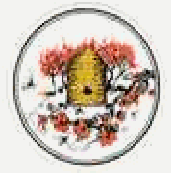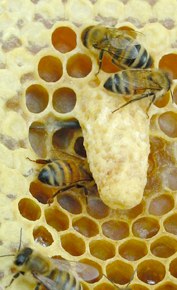|
Beginning Beekeeping:
IIs beekeeping hard work?
How much will it cost me to keep bees?
How much honey can one bee hive produce?
What do I do if I see a swarm of bees?
How do beekeepers catch a swarm?
How long does a bee live?
How many bees are in a bee hive?
Bee Stings:
Will I get stung if I keep bees?
What do I do if I get stung?
Why does a bee sting?
Why does a bee die when it stings?
What is Apitherapy?
Honey and other products:
How do bees make honey?
Why do bees make honey?
How does the beekeeper get the honey
from the bees?
Do the bees miss the honey
that is taken?
Anything else?

Beginning Beekeeping:

Q.
How much time does it take to manage a hive?
A.
About half an hour per hive per week, and less time during the winter.
In addition, honey is extracted once a year; this can take about
two hours per hive.

Q.
How much will it cost me to keep bees?
A.
For the clothing, tools and supplies it' will cost about £300 but there
are always bargains about and costs can be cut
considerably

Q.
How much honey can one bee hive produce?
A.
One hive could produce 50 pounds of honey in a good season. An average
hive, however, produces 20-30 pounds of surplus honey.

Q.
What do I do if I see a swarm of bees?
A.
Don't panic: bees in a swarm are universally in a good mood. They
cannot easily sting even if antagonized as they have gorged themselves
with honey and cannot get their bodies into the best position to
sting. If the swarm is not causing a nuisance then leave it -- gradually
the bees will cluster in a bush or tree and remain there for up
to three days. During that time scouts will be sent out to look
for a new home. If the swarm is a nuisance then call the police,
as they keep a list of local beekeepers who can help.

Q.
How do beekeepers catch a swarm?
A.
Beekeepers usually catch swarms when the bees collect on a branch
of a tree or bush. The beekeeper simply shakes the swarm into a
cardboard box that can be secured and has adequate vents. The swarm
is then taken to a prepared hive and simply shaken in. The new hive
may be made more enticing by adding some brood and capped honey,
from another hive. It is a dramatic sight to see a swarm marching
into a new hive.

Q.
How long does a bee live.
A.
In the summer, a worker bee only lives for about six weeks. The
workers born in the Autumn will live until the following Spring. A
queen can live up to five years. However, for the beekeeper, a queen
is beyond her prime in her third year. A beekeeper will usually
requeen a hive once a year.

Q.
How many bees are in a bee hive?
A.
In the summer there can be about 40,000 bees in a hive. This number
drops to around 5,000 in the winter.
Bee Stings:

Q.
Will I get stung if I keep bees?
A.
Yes. A few people are allergic, but most will have a swollen area
at the vicinity of the sting, that should last a few days. Most
people gradually become more immune to bee stings.

Q.
What do I do if I get stung?
A.
If
stung, scrape the stinger out with your fingernail, as the stinger
continues to pump venom for some time after insertion.

Q.
Why does a bee sting?
A.
A bee stings when it is provoked, it is frightened, it gets trapped
in hair, it is crushed, or the colony is threatened.

Q.
Why does a bee die when it stings?
A.
Essentially,
the bee loses its internals when it stings. The barbs in the sting
firmly stick into the victim, pulling out the venom sacs and glands
when the bee is shaken off.

Q.
What is Apitherapy.
A.
Apitherapy is the medicinal use of honeybee products: honey, pollen,
propolis, royal jelly, beeswax, and the venom.
Honey:

Q.
How do bees make honey?
A.
Bees take nectar, a sweet sticky substance exuded by most flowers
and some insects, and mix it with enzymes from glands in their mouths.
This nectar/enzyme mix is stored in hexagonal wax honeycomb until
the water content has been reduced to around 17%. When this level
is reached, the cell is capped over with a thin layer of wax to
seal it until the bees need it. This capping indicates to the beekeeper
that the honey can be harvested. Capped honey can keep almost indefinitely.

Q.
Why do bees make honey?
A.
Bee colonies do not hibernate during the winter, but stay active
and cluster together to stay warm. This requires a lot of food --honey--
stored from the summer before. Honeybees are special in that they
over-winter as a colony, unlike wasps and bumble bees. Although
a hive only needs 20-30 pounds of honey to survive an average winter,
the bees are capable, if given the space, of collecting much more.
This is what the beekeeper encourages through traditional beekeeping
practices.

Q.
How does the beekeeper get the honey from the bees?
A.
Ah, yes. The honey. The queen bee is kept below the upper
boxes in the hive (called "supers") by a wire or plastic grid which
the queen is too large to fit through (called a "queen excluder").
As the bees cannot raise brood above this queen excluder, only honey
is stored in the supers. As the season progresses, the beekeeper
adds more supers until it's time to harvest the honey. A special
one-way valve is then fitted in place of the queen excluder, and
gradually all the bees are forced into the lowest part of the hive.
The beekeeper can simply lift off the super boxes containing the
honey comb. The honey is extracted from the comb using centrifugal
force in a machine called a "spinner", which looks much like an
old fashioned upright spin dryer.

Q.
Do the bees miss the honey that is taken?
A.
No. A strong colony can produce two to three times more honey than
they need. If necessary, the beekeeper can feed the bees a sugar
syrup in the autumn to make up for the loss of honey.
Back to the Top |



